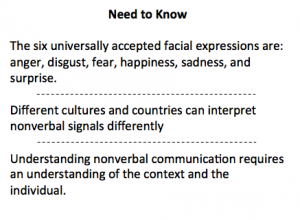When a Burp is a Thumbs Up: Culturing Your Nonverbal Communication. Nonverbal: Part Two
September 14, 2015 ~ Written by: W.B. “Bud” Kirchner
 “If we are strong, our strength will speak for itself. If we are weak, words will be of no help.” ~ John F. Kennedy
“If we are strong, our strength will speak for itself. If we are weak, words will be of no help.” ~ John F. Kennedy
Amongst my various duties at Kirchner Group, I get to preside over ‘premortems.’ That is where we chat (hypothetically) about what “went wrong” before we execute an initiative for ourselves or our clients/partners. Sound like I think glass is half empty?
Pragmatically speaking (on the back of a fifty year career), I have seen almost everything that can go wrong (I have fixed more broken businesses than most people have seen) and proceeding in this fashion has served Kirchner Group, our partners and our clients well.
Anyway, I thought it would be worth spending some effort considering what might be at play when nonverbal communication sends the wrong signal – or when the right signal is read wrong.
Learned Skills
While nonverbal communication appears to be a skill you can learn, as with most neurological based talents, the talent-level of skills varies.
Legendary in this context was a man named Silvan Tomkins (see the final chapter of “Blink” by Malcolm Gladwell) who was by all accounts a savant in reading microexpressions and more. Reportedly, he could look at wanted posters and predict the crime from the face.
Incidentally, Tomkins best way of putting his gift in context is he stated ‘the face is like the penis.’ Presumably, he meant it has a mind of its own?
Lest we become skeptical on the link between the sender’s face and body and the recipient’s receptors, there are many studies where individuals create a facial expression (e.g. hold a pen in your lips) and this has a measurable impact on their mood/emotions. Turns out, if you help your face smile you feel better and it works on the person you are building a relationship with. Who would have thought?
Nonverbal Qualifiers
Needless to say, nonverbal communication does not occur in a vacuum. You need to be mindful of the context and individuals such as:
- Personality
- This goes for both the senders and receivers.
- Context
- Someone might send different signals if the building were not on fire.
- Psychology
- Sociopaths (by definition will not show any (relevant) emotions).
- Lest, you think you won’t come across any in business, read “The Wisdom of Psychopaths” by Kevin Dunn
- Schizophrenia (and similar conditions).
- Similar Expressions
- Fear and surprise involve many of the same facial muscles.
- Thinking Errors
- Review my post “A Field Guide to Thinking Errors” for biases you may be relying on – and not know it.
- Your Attention
- If you snooze you lose – especially given the speed and subtlety of microexpressions.
- Jumping to Obvious
- Signals like clammy hands/sweaty brow could reflect a physiological condition.
There are other signals (for example, undue hesitations and too much attention to details) that tend to help interpret disconnects between verbal and nonverbal. Also, keep all this in mind as you watch for asymmetrical expressions or expressions that are prolonged in nature.
Thumbs Up Can Be A Thumbs Down
In addition to the ‘qualifiers’ in the previous section, one must be careful interpreting or sending nonverbal cues in other cultures. There are landmines that you need to watch for. However, more than a bit like having a verbal conversation in your nonnative language,.just as some people learn languages easier, some adapt to nonverbal better.
I thought this was an issue worth pursuing given so much discussion of the dominance of nonverbal; and given how, in many ways, signals are universal (per evolution); and given how many business people have suppliers, manufacturers, customers and investors in other cultures.
Research has shown, and it is widely accepted today, that there are six universally accepted facial expressions: anger, disgust, fear, happiness, sadness and surprise.
The book “Language and Intercultural Communication in the New Era,” Farzad Sharifian and Maryam Jamarani point out (on page 118) those expressions are based on the early research of Paul Ekman and his colleagues who went so far as to study “two preliterate tribes—the Fore and the Dani—in the highlands of New Guinea” to back their findings.
In more recent research, there are arguments to add and subtract emotions from the list. An often cited study is Jonathan Haidt and Dacher Keltner’s “Culture and Facial Expressions: Open-ended Methods Find More Expressions and a Gradient of Recognition.” On page 260 they argue for adding embarrassment, amusement and contempt but getting rid of sadness.
Having said all this, there are always exceptions: smiling in much of Scandinavia and Russia could be a sign of too much emotion; in China and Japan smiling could be interpreted as masking sadness – they cannot share sadness.
“smiling in much of Scandinavia and Russia could be a sign of too much emotion; in China and Japan smiling could be interpreted as masking sadness – they cannot share sadness.”
I have done business in 28 countries (so I’ve seen a few) and I’ve been sensitized to others but not always in a pleasant fashion. Clearly, different languages exacerbate a situation because you are relying even more on nonverbal communication.
The classic example is head nodding. In the Middle East, the “yes” and “no” signals are reversed.
Thumbs up can have negative implications. In Latin America and some parts of the Middle East, it is vulgar.
Eye contact is usually interpreted to be rude and offensive in Middle East.It is also considered an insult in the Middle East and sections of Europe to show the sole of your shoe to someone (as in feet on the desk) – even if you’re the President.
Still another example is in the category of proxemics (and the illustration that nothing is simple), there was a period when I was doing business simultaneously in Brazil and Thailand. The former, an area where embrace is an important threshold, while the latter quite the contrary. Each flight I needed to ‘deprogram’ myself!
Finally, in the category of things that won’t make/break your deal (although I have seen stranger things happen) a belch is flattering to the cook in India.
“All meanings, we know, depend on the key of interpretation.” ~ George Eliot, author
In a previous post I talked about the importance of people based due diligence. You should view this post as a reminder to do your cultural based due diligence. The more research you do about a culture – the better you will be. Better prepared. Better received. Better success. Better business.
Now if you really want to get into the weeds – a good jumping off point is “Culture and Nonverbal Behavior,” by David Matsumoto.
About the Author: W.B. “Bud” Kirchner is a serial entrepreneur and philanthropist with more than 50 years of business success. He is not a scientist or an academic but he does have a diversified exposure to neuroscience, psychology and related cognitive sciences. Generally speaking, the ideas he expresses here are business-angled expansions of other people’s ideas, so when possible, he will link to the original reference.
